Sometimes we have been very lucky in our travels. Many times we end up in a place just in time for a festival or celebration that we had no idea was even going on. This was the case in Bali when visiting Ubud and a massive cremation ceremony was taking place.
We don’t plan our travels around events like this, so we had no idea it was going on when we arrived. It wasn’t until our guesthouse owner told us about it and other shop keepers mentioned that we should go.
Especially one that was so prominent.
Witnessing a Cremation Ceremony in Bali
Table of Contents
We had heard of the famous cremation ceremonies of Bali and we had seen them on T.V. but we never thought that we would actually witness one in real life.
We didn’t even know if it was proper etiquette for us to attend a cremation ceremony, but when shop owners and waitresses told us that we must see the cremation how could we not?
It seemed that everyone was asking us if we were going to see the cremation ceremony and it seemed that everyone in town was going.
What is Cremation Ceremony in Bali
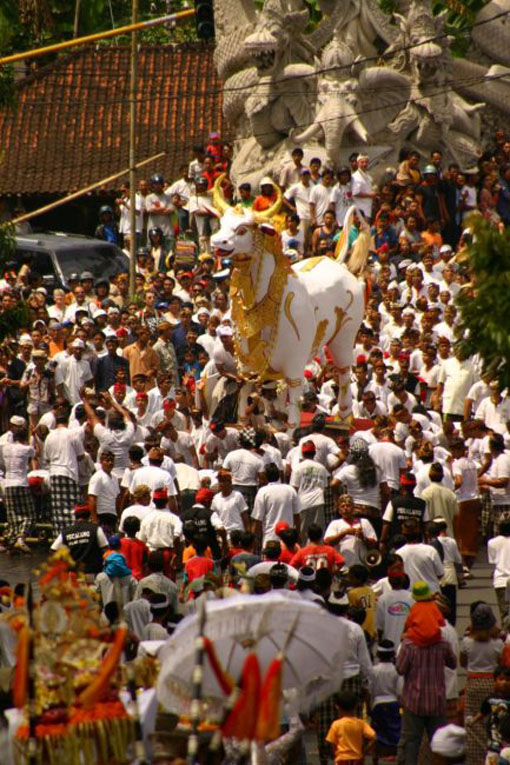
The cremation ceremony is a sacred right of passage in Bali. It is a funeral celebration for a loved one.
But a cremation ceremony isn’t like the usual funeral service that we in the west are accustomed to.
It is instead a time for celebration and a time for the deceased’s body to be burned and set free from its worldly ties.
It is the most important ceremony in a person’s life in Bali. It is a celebrated stage in a person’s life and no expense is spared.
This is the last ceremony in the circle of life where it must be done properly to convey the deceased soul to the eternal world.
To Witness a Cremation ceremony is very rare.
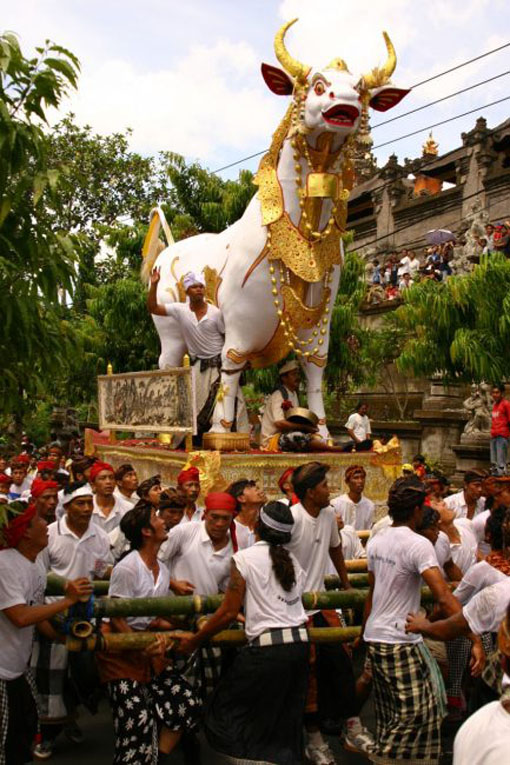
Sometimes it can take years after a person’s death for a cremation to take place.
Poorer families save money over time to be able to pay for the ceremony and they have mass cremations together.
The bodies are temporarily buried until the day arrives.
We were in Ubud when a very prominent priest passed away and could afford to have his own elaborate cremation ceremony.
There are three types of cremation ceremonies in Bali.
- One for ordinary people known as Ngaben.
- Plebon is a cremation ceremony for the royal family
- Pretiwaan is for a high priest.
I can’t believe that we were in Bali for Pretiwaan, the most important of cremation ceremonies. All these people were attending one person’s cremation
A Cremation Ceremony is a Festive Event
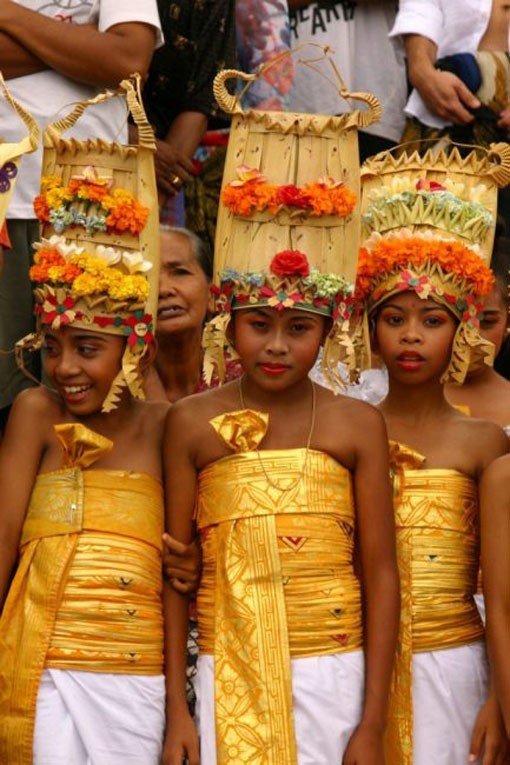
We arrived to a mass of people dressed in traditional ceremonial clothing.
Bands were playing and people carried ornate offerings on their heads and others walked through the crowd selling sarongs and chess sets.
Soon the procession appeared at the end of the street and the ceremony began.
It was led by a massive white sacred cow carried by dozens of sarong clad men.
The crowd fell into place and the procession grew. Thousands of people filled the street.
The Balinese music played and the tin drums could be heard from everywhere.
The atmosphere was festive and exciting. People yelled and cheered and the energy was intoxicating.
The Parade
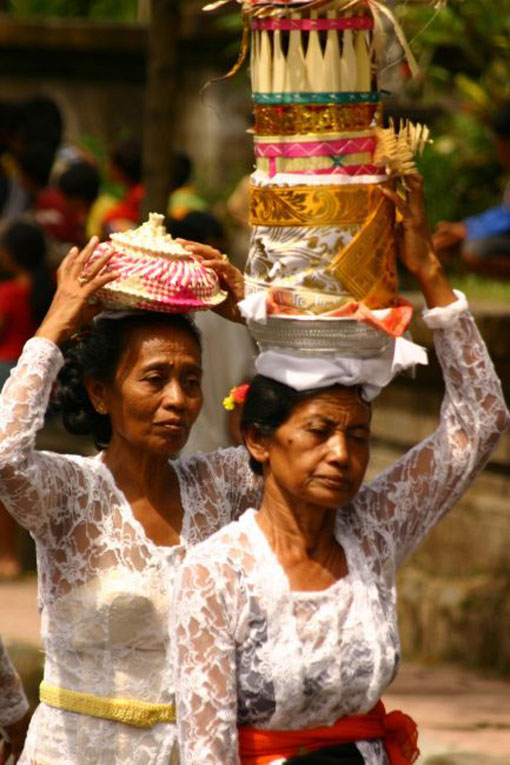
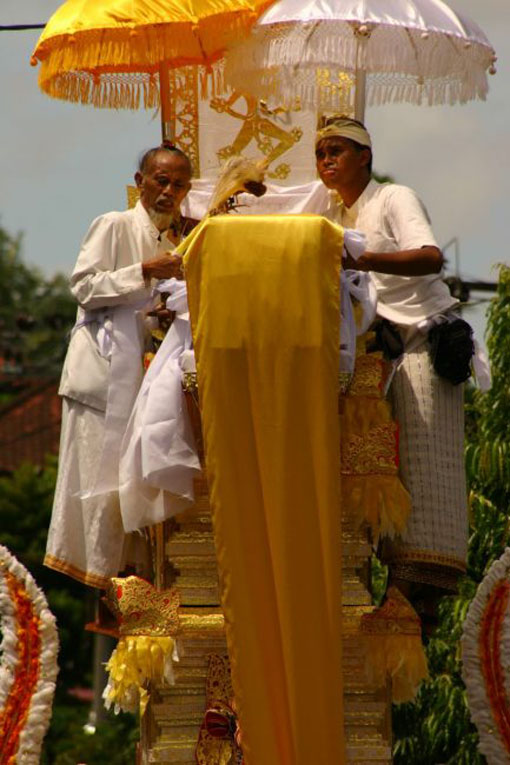
The parade is a time to celebrate life. Hundreds of people carry objects through the streets towards the end location.
The high tower containing the body followed.
It was resting on giant bamboo poles being carried by dozens of men.
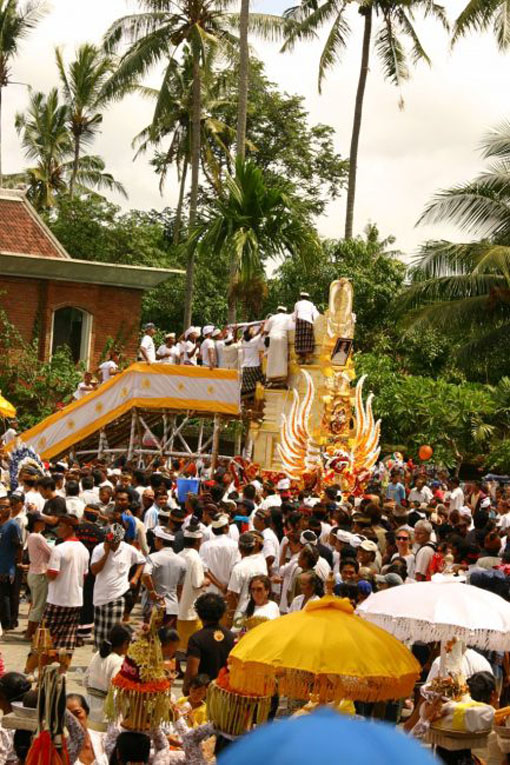
Every so often the men carrying the tower would stop and turn in circles.
From what I understand, they were trying to confuse the spirit. They don’t want it to find its way home. This ritual is meant for the spirit to leave the earth forever.
So the long parade route is not only just for show, it is actually a part of the ceremony and their beliefs.
They believe that if the spirit can find its way back, it will haunt the family. This ceremony is to let the spirit move on in peace.
The Priest
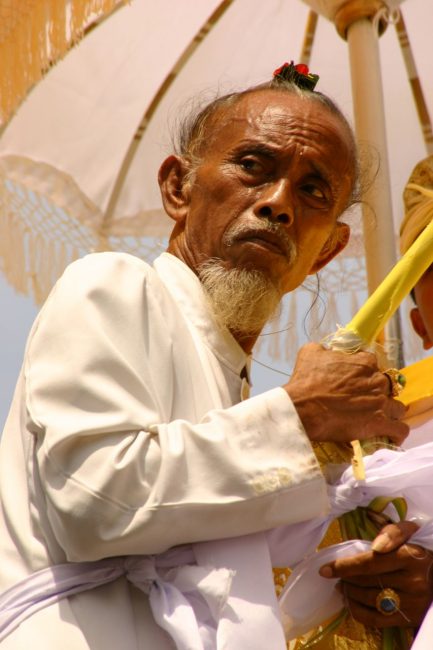
A priest stood beside the shrine along with another man who could have been the deceased eldest son or relative.
We never did find out what his role was.
At this point after the body and the priest passed, we joined the procession following it all the way to the temple where the actual ceremony would take place.
It was a very hot day. The sun beat down and the concrete burned through the soles of our flip flops.
We were sweating in the intense sun, but we could not miss this once in a lifetime experience.
The Preparation

The band found a spot to sit where it continued to play as the body was prepared.
Wreaths were displayed in front of the alter and the body was transferred from the tower to be burned inside the statue of the white cow.
I could not see exactly what was happening, but they took great care of wrapping the body and filling the shrine with offerings.
Burning of the Cow
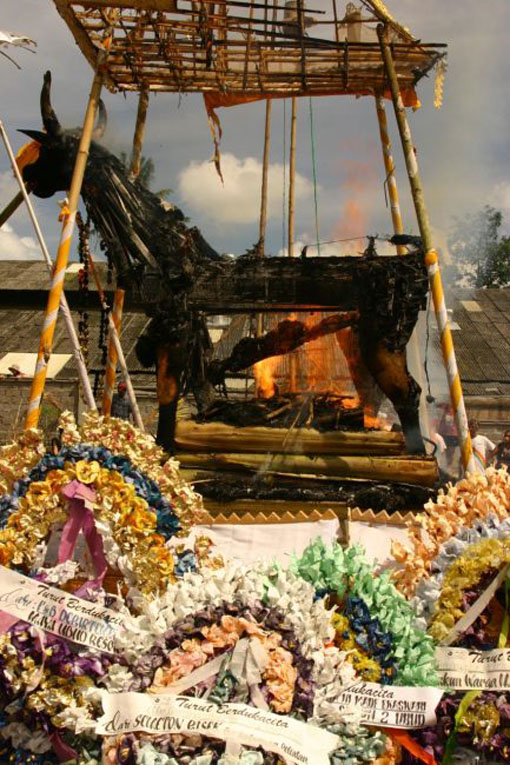
After an hour of anticipation, quite suddenly and silently the fire was lit. I had my back turned and it wasn’t until the cow was engulfed in flames did I realize that the cremation was taking place.
The intense heat caused even the most curious to step back.
The cow took a long time to burn and the head never did.
Eventually, the body fell underneath the cow and that is when they really fueled the fire to burn the bones. The intense eat focused on the body to finish the cremation.
It was strange. You could see the skeleton burning and morbid tourists, myself included, rushed to the front to take a closer view.
The band played on and people cheered as the cremation ceremony came slowly to an end.
It was yet another surreal experience in our Asian Adventure.
However it really was a spectacular sight and awesome to see how death can be about celebration as well as grieving. A cremation ceremony in Bali shows that life is worth celebrating. We all have to die one day, we should embrace the afterworld and pay tribute to a life lived.
Read More




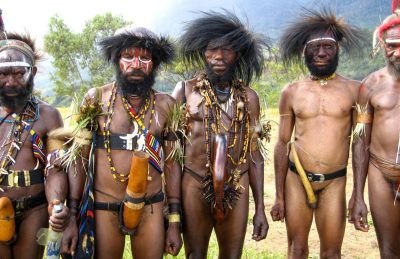



In India, they publicly cremate their kings and high persons in their village. Thanks for sharing those great photos. It is like we’ve also witness the ceremony.
Mike,
What is Cremation
You have great shots here. It is really a big cremation event. I just wonder how many people were carrying the cow like urn?
Wow, the colors of the ceremony are absolutely incredible. I agree, seems like a lot of work, but many other cultures find great joy in perperations, unlike us lazy westerners.
VERY interesting article.. Thanks for posting this. It Is always nice to get an insight on other cultures viewpoints on cremation and cremation ceremonies.
Tim Bryan
BryanWoodUrns
wood urn
.-= Tim Bryan´s last blog ..Controlling Funeral Costs with a custom wood urn =-.
my girlfriend, Gerlyn and myself were celebrating my BD in Aug and we also had the privilege to witness the ceremony. The cremation is common but Tempo Dulu has confused this ceremony with the ordinary one, the last one before this was 7 years ago! your pics were well taken indeed, we don’t have one that matches your quality, and which spot did you get that ariel view? 🙂
That was my 3rd visit to Bali but Gerlyn’s 1st, it was both our 1st time to stay in Ubud and Ubud is truly BALI! As a matter of fact, as soon as we return to Singapore, where myself came from, we booked our next trip to Ubud this coming X’mas, this time to celebrate Gerlyn’s BD.
Hi Andrew. The arial view was from a stage that we climbed up on. It is quite amazing. Yes, the real mass cremation ceremonies only happen every few years, so we are all very lucky to have been there at the right time to witness it. We love Ubud too, have a great Christmas there and get yourself a massage. It is heaven. Climbing Gunung Batur is worth it as well. Let us know how your trip goes. Cheers Dave and Deb
great pics and glad you liked the experience, but such cremations are actually very common in Bali.
.-= Tempo dulu´s last blog ..40 things to do in Indonesia before you die =-.
Again, what timing!!!!!! I’m doing something seriously wrong, or the countries I’m visiting and living in just don’t have anything remotely this ornate or interesting or just plain mind blowing.
Glad to see this from you guys!!!!!
What a unique experience! Your photos are amazing and add an important visual to the story of the cremation ceremony in Ubud.
.-= Jennifer´s last blog ..On Fire: Touring Mount Vesuvius =-.
Thanks for the great description and pics of a unique cultural event.
A cool way to go out although seems like a lot of effort for a funeral. Maybe that’s just me though, I’m not too concerned what happens to my body after I’m gone.
.-= Anil´s last blog ..123test =-.
It’s interesting to learn how other cultures deal with the passing of life and what happens after death. I definitely prefer the pomp and celebration of a culture like this one, or the idea behind a “wake’, much more than the mournful, depressing bleakness of traditional funerals here. I’d rather have my life celebrated than my death mourned. Great photos too!
.-= Trisha´s last blog ..Suzy: Week 7 Goals – Adding Fresh Content =-.